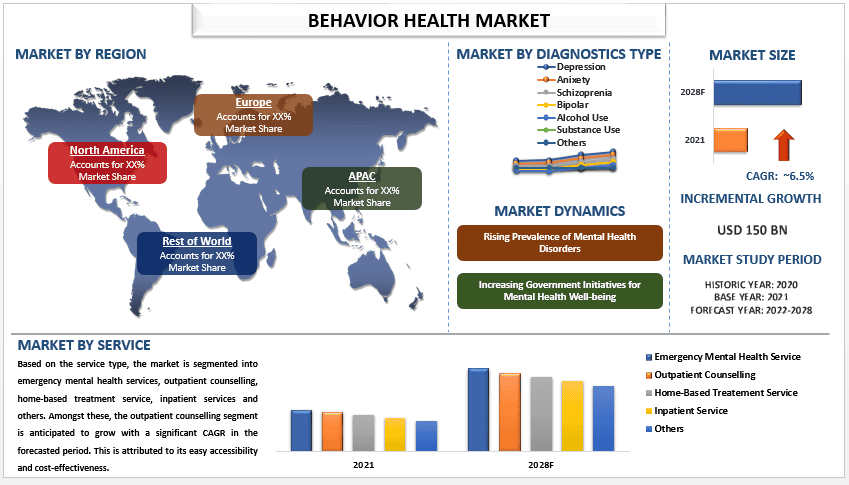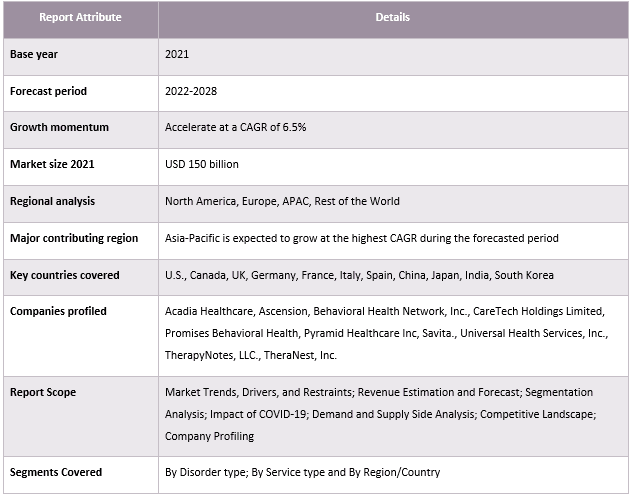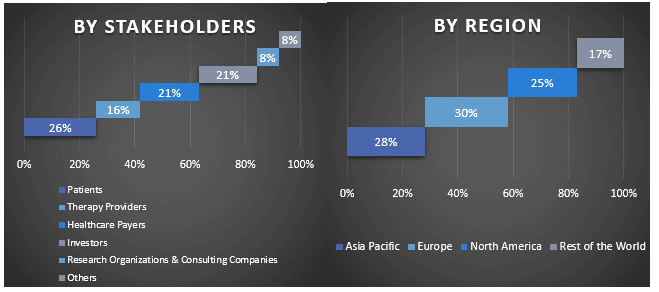- Home
- About Us
- Industry
- Services
- Reading
- Contact Us
Behavioral Health Market: Current Analysis and Forecast (2022-2028)
Emphasis on Type (Depression, Anxiety, Schizophrenia, Bipolar, Alcohol Use, Substance Use and Others), End-Users (Emergency Mental Health Services, Outpatient Counselling, Home-Based Treatment Service, Inpatient Services and Others); and Region/Country

The behavioural health market was valued at USD 150 Bn and expected to grow with a CAGR of 6.5% during the forecast period (2022-2028).The rising prevalence of mental health disorders including depression and anxiety globally, has resulted in productivity arising due to these disorders. This has cost a loss of 1 trillion economy each year, owing to this, WHO launched initiatives for providing quality care to the mental health of the people. For instance, in 2019, WHO launched special initiatives for mental health that aims to ensure access to mental health services for 100 million more people across WHOs six regions. This is driving the market growth for the behavioral health market in the forecasted period.
Some of the major players operating in the market include Acadia Healthcare, Ascension, Behavioral Health Network, Inc., CareTech Holdings Limited, Promises Behavioral Health, Pyramid Healthcare Inc, Savita. Universal Health Services, Inc., TherapyNotes, LLC., TheraNest, Inc.
Insights Presented in the Report
“Amongst disorder type, the depression segment is growing with significant CAGR in 2021 market”
Based on type, the market is segmented into depression, anxiety, schizophrenia, bipolar, alcohol use, substance use and others. Amongst these, the depression segment is anticipated to grow with a significant CAGR in the forecast period. This is attributed towards the rising prevalence of depression worldwide. For instance, according to WHO 2023 report, an estimated 3.8% population in the world have depression, including 5% of adults, and 5.7% of adults older than 60 years of age. Additionally, as per the above-mentioned source, approximately, 280 million people in the world have depression. Further, various environmental factors such as drug abuse, severe financial losses or related issues have significantly contributed to the prevalence of depression. Thus, these above-mentioned factors are anticipated to fuel the growth of this segment in the forecasted period.
“Amongst service types, the outpatient counselling segment is growing with a significant CAGR in the market in 2021”
Based on the service type, the market is segmented into emergency mental health services, outpatient counselling, home-based treatment services, inpatient services and others. Amongst these outpatient treatment services are anticipated to grow with a significant CAGR in the forecasted period. This is attributed to convenience and accessibility. Outpatient counselling services are more accessible than inpatient counselling services, making it easier for the patient to receive care without disrupting their daily lives. Additionally, outpatient counselling is generally less expensive than inpatient counselling services, making it accessible to individuals with low. Further, the advancement in technology, such as telehealth, has made it possible for the patient to receive counselling remotely, without visiting the place physically. These above-mentioned factors have significantly contributed towards the growth of this segment in the forecasted period.
Behavioral Health Market Report Coverage

“Asia-Pacific is anticipated to grow with significant CAGR of the behavioral health market in 2021”
Asia-pacific is anticipated to grow with a significant CAGR in the 2021 market. This is attributed towards the initiatives taken by the government have significantly focused on the mental health of the people. For instance, in 2020, the government of India, under the Ministry of Electronics and Communication launched a digital India campaign which includes the e-Sanjeevni platform, providing telemedicine services to people in a remote area. Additionally, other initiatives launched by the government for the mental health of the students are also driving the market growth in this region. For instance, in 2021, the Government of India under the Ministry Of Human Resource and Development launched Manodarpan, to provide psycho-social support and counselling to students for their mental health and well-being. These above-mentioned initiatives taken by the government for mental health are boosting the market growth for the behavioral health market in this region in the forecasted period.
Reasons to buy this report:
- The study includes market sizing and forecasting analysis validated by authenticated key industry experts.
- The report presents a quick review of overall industry performance at one glance.
- The report covers an in-depth analysis of prominent industry peers with a primary focus on key business financials, product portfolios, expansion strategies, and recent developments.
- Detailed examination of drivers, restraints, key trends, and opportunities prevailing in the industry.
- The study comprehensively covers the market across different segments.
- Deep dive regional level analysis of the industry.
Customization Options:
The global behavioral health market can further be customized as per the requirement or any other market segment. Besides this, UMI understands that you may have your own business needs, hence feel free to connect with us to get a report that completely suits your requirements.
Table of Content
Research Methodology for the Behavioral Health Market Analysis (2022-2028)
Analyzing the historical market, estimating the current market, and forecasting the future market of the global behavioral health market were the three major steps undertaken to create and analyze the adoption of behavioral health in major regions globally. Exhaustive secondary research was conducted to collect the historical market numbers and estimate the current market size. Secondly, to validate these insights, numerous findings and assumptions were taken into consideration. Moreover, exhaustive primary interviews were also conducted, with industry experts across the value chain of the global behavioral health market. Post assumption and validation of market numbers through primary interviews, we employed a top-down/bottom-up approach to forecasting the complete market size. Thereafter, market breakdown and data triangulation methods were adopted to estimate and analyze the market size of segments and sub-segments of the industry pertains to. Detailed methodology is explained below:
Analysis of Historical Market Size
Step 1: In-Depth Study of Secondary Sources:
Detail secondary study was conducted to obtain the historical market size of the behavioural health market through company internal sources such as annual reports & financial statements, performance presentations, press releases, etc., and external sources including journals, news & articles, government publications, competitor publications, sector reports, third-party database, and other credible publications.
Step 2: Market Segmentation:
After obtaining the historical market size of the behavioral health market, we conducted a detailed secondary analysis to gather historical market insights and share for different segments & sub-segments for major regions. Major segments are included in the report as disorder type and service type. Further country-level analyses were conducted to evaluate the overall adoption of testing models in that region.
Step 3: Factor Analysis:
After acquiring the historical market size of different segments and sub-segments, we conducted a detailed factor analysis to estimate the current market size of the behavioral health market. Further, we conducted factor analysis using dependent and independent variables such as disorder type and service type of the behavioral health market. A thorough analysis was conducted for demand and supply-side scenarios considering top partnerships, mergers and acquisitions, business expansion, and product launches in the behavioral health market sector across the globe.
Current Market Size Estimate & Forecast
Current Market Sizing: Based on actionable insights from the above 3 steps, we arrived at the current market size, key players in the global behavioral health market, and market shares of the segments. All the required percentage shares split and market breakdowns were determined using the above-mentioned secondary approach and were verified through primary interviews.
Estimation & Forecasting: For market estimation and forecast, weights were assigned to different factors including drivers & trends, restraints, and opportunities available for the stakeholders. After analyzing these factors, relevant forecasting techniques i.e., the top-down/bottom-up approach were applied to arrive at the market forecast for 2028 for different segments and sub-segments across the major markets globally. The research methodology adopted to estimate the market size encompasses:
- The industry’s market size, in terms of revenue (USD) and the adoption rate of the behavioral health market across the major markets domestically
- All percentage shares, splits, and breakdowns of market segments and sub-segments
- Key players in the global behavioral health market in terms of products offered. Also, the growth strategies adopted by these players to compete in the fast-growing market
Market Size and Share Validation
Primary Research: In-depth interviews were conducted with the Key Opinion Leaders (KOLs) including Top Level Executives (CXO/VPs, Sales Head, Marketing Head, Operational Head, Regional Head, Country Head, etc.) across major regions. Primary research findings were then summarized, and statistical analysis was performed to prove the stated hypothesis. Inputs from primary research were consolidated with secondary findings, hence turning information into actionable insights.
Split of Primary Participants in Different Regions

Market Engineering
The data triangulation technique was employed to complete the overall market estimation and to arrive at precise statistical numbers for each segment and sub-segment of the global behavioral health market. Data was split into several segments & sub-segments post studying various parameters and trends in the areas of disorder type, and service type in the global behavioral health market.
The main objective of the Global Behavioral Health Market Study
The current & future market trends of the global behavioral health market were pinpointed in the study. Investors can gain strategic insights to base their discretion for investments on the qualitative and quantitative analysis performed in the study. Current and future market trends determined the overall attractiveness of the market at a regional level, providing a platform for the industrial participant to exploit the untapped market to benefit from a first-mover advantage. Other quantitative goals of the studies include:
- Analyze the current and forecast market size of the behavioral health market in terms of value (USD). Also, analyze the current and forecast market size of different segments and sub-segments
- Segments in the study include areas of the disorder type and service type.
- Define and analysis of the regulatory framework for the behavioral health industry
- Analyze the value chain involved with the presence of various intermediaries, along with analyzing customer and competitor behaviors of the industry
- Analyze the current and forecast market size of the behavioral health market for the major region
- Major countries of regions studied in the report include Asia Pacific, Europe, North America, and the Rest of the World
- Company profiles of the behavioral health market and the growth strategies adopted by the market players to sustain in the fast-growing market
- Deep dive regional level analysis of the industry
Related Reports
Customers who bought this item also bought










